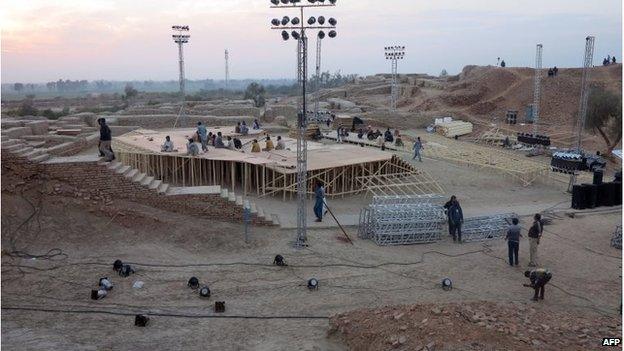Pakistan's Mohenjo Daro ruins 'threatened by festival'
- Published

Organisers insist the site is not being harmed, as workers add a stage and lighting
Conservationists in Pakistan have asked Unesco to stop part of a cultural event being held on a World Heritage site.
The group of scholars and archaeologists say the opening ceremony of the Sindh cultural festival could damage the ruins of Mohenjo Daro.
It is the world's oldest surviving city and dates back to the pre-Hindu Indus Valley civilisation.
The festival is the brainchild of the young leader of the Pakistan People's Party, Bilawal Bhutto Zardari.
The BBC's Shahzeb Jillani in Karachi says official arrangements for the opening ceremony are in full swing - but leading conservationists are outraged.
Holding the festival in Mr Bhutto Zardari's home province is seen as an attempt to strengthen his local credentials - something that critics, citing his foreign education and privileged upbringing, fault him for.
The son of former President Asif Ali Zardari and Prime Minister Benazir Bhutto, who was assassinated six years ago, he has spent much of his life abroad.
In a rare interview earlier this week with the BBC's Lyse Doucet, he spoke passionately about the need to save Pakistan's cultural heritage, including Mohenjo Daro, now crumbling and in need of restoration.
But many of those treasured sites, including Mohenjo Daro, lie in his party's stronghold, and leading conservationists accuse his provincial government of disregard for preservation.
They are worried that the construction work needed for the festival's opening ceremony could irreparably damage the 5,000-year-old site, and have written to the UN's heritage body, to ask it to intervene.
Mr Bhutto Zardari has dismissed the criticism, saying organisers are taking the utmost care and that the event will go ahead on Saturday.
Large wooden and steel scaffolding is being erected over and around the ruins, while heavy spotlights and lasers have been installed for a light show.
Farzand Masih, head of the Department of Archaeology at Punjab University, said such activity was banned under the Antiquity Act.

Cultural celebration or political branding? Critics claim it is just a way to raise Mr Bhutto Zardari's profile
"You cannot even hammer a nail at an archaeological site," he said. "The laser and spotlights, secondly, will cause rapid decay at the site which is already exposed to many negative factors." He added that he had declined an invitation to attend.
Qasim Ali Qasim, head of the Sindh Archaeology Department that is responsible for the ruins, denied any damage was being done.
"I don't think that the structure or lights would harm the site," he said. "I am personally overseeing the work and it is all in accordance with the SOPs (standard operating procedures)."
Sindh's High Court later agreed to hear a case filed by lawyer Qazi Ali Azhar that seeks to stop the government building on the site.
Unless "extreme care" is taken in making arrangements for the show, the site may be damaged and this would be a "great national tragedy", said the short order from the court's Chief Justice Syed Maqbool Baqir.
The ruins, discovered in 1922 by British archaeologist Sir John Marshall, are 425km (265 miles) north of the port city of Karachi.
They are one of Pakistan's six Unesco World Heritage sites deemed places of special cultural significance.
But many of the country's historical sites are crumbling through neglect, endangered by vandalism and urban encroachment, as well as a booming trade in illegally excavated treasures.
- Published27 June 2012
- Published30 January 2014
- Published28 January 2014